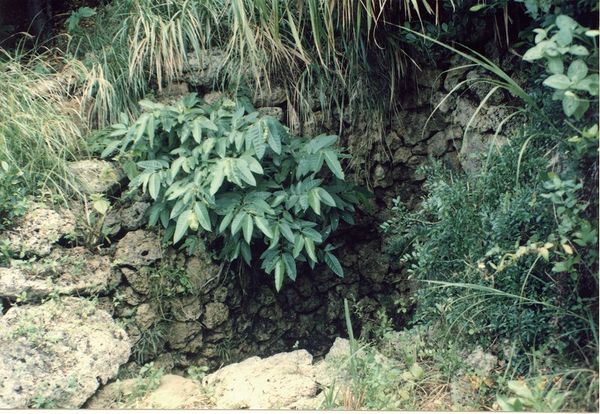トップ > 市の組織 > 教育委員会 > 生涯学習部 > 生涯学習振興課 > 【市指定有形民俗文化財】 クスヌカー(後の井)
【市指定有形民俗文化財】 クスヌカー(後の井)
〔くすぬかー〕
クスヌカーは、狩俣集落に古くから伝わるウャーン(祖神祭)祭祀のニーリ(神歌)の中で、「時の酉長と伝わるウプグフトゥヌ(大城殿)が井戸の掘削を思い立ち、甥と相談し、村人たちを呼び集めマイツ(手斧)・ブナ(大斧)などの鉄製道具を使い、クスヌカーを掘ったところ、うまい水が豊富に湧きだしたので、人々は余りの嬉しさに村を挙げて四日三晩祝った。」と歌われており、歌詞で理解できるように飲料水が乏しかったころの人々の水に対する渇望や願い、鉄の伝来を語っている。
また、クスヌカーは狩俣の民俗行事シツ(節)と深く関わっており、旧暦5・6月の甲午の日の未明、娘たちは、友達同士連れ立ってクスヌカーの前方の海に入り、胸高の深さのあたりをシツのアーグを歌いながら西に東に歩く。夜が明ける頃、海から上がりクスヌカーの水を浴びて身を清める。いわゆる脱皮再生の若返りの水、バーミズ(若水)である。
このようにクスヌカーは古い時代の主要な水源としてはもとより、シツの祭事や若水の民俗礼儀のほか、鉄器の伝来や集落の歴史と深く関わり、それらを知る上でも重要な井泉である。
【Tangible Folk Designated by the City】 Kusunuka
There is a Niri, or worship song about Kusunuka, sung during the Ueyan (ancestral worship festival) which has been celebrated at the Karimata settlement since long ago. The song mentions that Upugufutunu, said to have been the leader of the people at the time, had an idea to dig a water well. He spoke with his nephew and gathered the people of the village and they used iron-made equipment like Maitsu (hatchets) and Buna (broadaxes) to dig the Kusunuka. The people were delighted when good water started to flow abundantly and the whole village celebrated for three nights and four days. As can be understood from this song, it sings of the yearning and hopes of the people for water, during a time when water was scarce, along with how iron came to be handed down.
In addition, the Kusunuka is deeply related to the folk festivity of Karimata, called the Shitsu, when maidens enter the ocean in front of the Kusunuka together with their friends in the early hours of the morning on the day of the horse, or Kinoeuma, in May/June of the lunar calendar. The girls walk to the west and to the east in the ocean at chest-deep, singing the Aagu of the Shitsu. Then they come out of the sea at down and purify themselves by pouring the water of Kusunuka over themselves. This is what can be called the rite of emergence and renewal, the restoration of youth with the Bamizu, or the first water.
In this way, the Kusunuka was not only an important source of water in the ancient times, but it is an important spring that helps us understand the people’s rites and ceremonies of the Shitsu and Bamizu, and deeply related to the handing down of iron equipment and the history of the settlement.
【市指定有形民俗文化財產】 後之井
後之井在狩俣村落流傳至今的祖神祭祀時,唱的尼里(神歌)中有歌詞形容如下:「傳言當時的酉長烏普古夫突奴(大城殿)想要掘井,於是與外甥商量召集村人,用手斧和大斧等鐵製工具挖掘後之井,美味井水豐湧而出,人們歡喜之餘全村慶祝四天三夜。」歌詞傳達了當時缺乏飲用水的人們,對於水的渴望和追求,以及鐵器的傳來。
不僅如此,後之井還與狩俣的民俗活動「節」有著密切的關係。舊曆5・6月份的甲午日的淩晨,年輕女子們紛紛進入後之井前方的大海,在深達胸部左右高度的海水中,邊唱「節」的民謠邊往西或往東走動。天亮後,女子們上岸,用後之井的水沐浴淨身。換句話說,此水是具有脫皮再生功效的返老還童之水(若水)。
後之井不但是古時候的主要水源,還與「節」的祭祀活動和若水的民俗禮儀、鐵器的傳來,以及村落的歷史都有甚深的關係,是瞭解這些內容的重要井泉。
【미야코지마시 지정 유형 민속】 구스누카 우물
구스누카는 가리마타 마을에 옛부터 전래되는 우얀(조상신의 죽제) 제사의 니리(신의 노래) 에는 다음과 같은 내용이 있다. “당시 추장이라고 전해지는 우푸구후투누(대성전)가 우물을 팔 것을 결심하고, 조카와 의논하여 마을 주민을 불러 모았다. 마이쓰(손도끼), 부나(큰 도끼) 등의 철제 도구를 이용, 구스누카를 팠더니 수량이 풍부하고 맛있는 물이 나왔다. 사람들은 너무 기뻐서 마을 전체가 하나가 되어 4일 밤낮을 축하하였다”. 이 가사에서 물이 부족했던 당시 사람들의 물에 대한 갈망과 소원, 철의 전래 등을 알 수 있다.
또한, 구스누카는 가리마타의 민속 행사인 시쓰(節)와 깊은 관련이 있다. 음력 5월과 6월 갑오날 새벽, 처녀들은 벗과 함께 구스누카 앞에 있는 바다에 들어가, 깊이가 가슴 정도에 차는 부근을 시쓰의 아구를 노래하면서 여기저기 돌아다닌다. 해가 뜰 무렵 바다에서 나와 구스누카의 물로 몸을 깨끗이 씻는다. 소위 말하는 껍질을 벗고 다시 태어난다는, 젊어지는 물, 바미즈(젊음의 물)이다.
이렇게 구스누카는 옛부터 주요한 수원으로써 뿐만 아니라, 시쓰의 제사나 바미즈의 민속 의례, 철기의 전래, 마을 역사와 깊은 관련이 있었다. 이를 이해하는데 있어서도 중요한 샘이다.
生涯学習部 生涯学習振興課
電話:0980-72-3764






